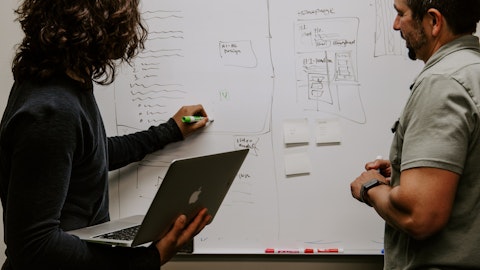Rob Brown: Okay, great. Thank you. I’ll turn it over.
Mike McCann: Thank you, Rob.
Operator: Thank you. Our next question comes from the line of Gerry Sweeney with ROTH Capital. Please proceed with your question.
Gerry Sweeney: Good morning, Jayme and Mike. Thanks for taking my call.
Mike McCann: Good morning.
Jayme Brooks: Morning.
Gerry Sweeney: I just wanted to stick on some of the same topics Rob has just mentioned, and specifically ODR growth. And, Mike, I think you and I have talked a little bit about this, but I wanted to retouch it and just get freshened up. I’m just curious how deep you are with some of your current customers. I think there’s a wallet share play here. So my question is this, how much more wallet share do you have with existing customers? How much of this ODR growth can come from wallet share? And then the third part, sorry, is just maybe new entrants or new opportunities, new customers, et cetera.
Mike McCann: Sure. It’s interesting, I’ve always said before that we’re in the early innings of our strategy. In some sense, that really equates to where we are from a customer basis perspective. So we’ve talked to tons of customers, and based upon describing what we do, there’s no doubt in my mind that they desire to have the type of services and relationships that we want to have with our customers. So I look at it from where we’ve grown from — just from our ODR revenue segment. A lot of that has really come from the expansion of existing relationships. So at the end of the day, we’re targeting relationships that have long term spend opportunity, multiple buildings. I mentioned some of this in the script, but they want — we’re very much at the early stages of those relationships with our customers.
So I would tell you, come back around to your wallet share question. While these customers, we have a small amount of market share and wallet share, but there’s a tremendous amount of opportunity and there’s the demand there to expand it. It’s up to us to make sure that we continue to dedicate those resources. That example I used previously before about that Life Science customer is kind of a perfect example. It’s going to start with some smaller POs and it’s going to build to larger capital projects over a period of time. But we’ll always have that steady OpEx work as that CapEx work builds over a period of time. So from — just from a new opportunity, even from a customer basis, a lot of those relationships right now are based on recommendations.
So if working on a Life Science facility or Healthcare facility, everybody knows everybody. And they see that we’re doing a good job of providing a high level of service. We’ve had — we started to have people call and say, can you come over to my building as well too? So it’s very much in the early innings and there’s a tremendous opportunity to gain market share and wallet share as we continue our journey.
Gerry Sweeney: Got it. And then the follow-up would be to this is just discussing opportunities to expand into some adjacent services. Obviously, rental is a prime example. Just curious, what are the opportunities? But I think also as importantly, how do you decide what to — what opportunities to pursue? I mean, given your size, you’re still a small cap, you’ve got some great wallet share to go. But how do you decide what is the appropriate business to go after and while still staying focused on that ODR — that broader core ODR opportunity?
Mike McCann: Sure. So in our investor deck, we have a new slide that talks about our unique offerings. Slide 10 in there and there’s, I think, 10 different offerings. And the way that we’ve kind of separated this out, Gerry, is that there’s three or four of them that are directly related to OpEx. It’s the rental, critical services, data-driven solutions. There’s another group of them that’s really related to the CapEx, which is MEP infrastructure projects, equipment upgrades & products. We have our PM services that we’re doing — program management, and then there’s kind of the more evolved offering. So we’ve kind of separated in our mind. I agree, can’t do everything at once. Got to make sure it’s very measured and it’s got to make sure that it aligns with the customers.
So very much thinking about this OpEx type of smaller project work, and then we’re really setting ourselves up for next year for the capital project work. And then again, some of these more evolved offerings. So it’s a very measured strategy over a period of time. We’re always trying not to do too much at once.
Gerry Sweeney: Got it. And maybe one quick question for Jayme. Obviously, you gave the guidance $49 million to $53 million on the adjusted EBITDA side, I believe there are a couple of add-backs or write-up some projects and sort of lack a better term, one-timers in 2023 results. I apologize, I hadn’t right in front of me, but I think it was especially in Q3. Could you go over some of those add-backs from 2023? Because I think that gives a little bit better apples-to-apples comparison on the EBITDA increase and projected EBITDA increase in ’24 over ’23.



